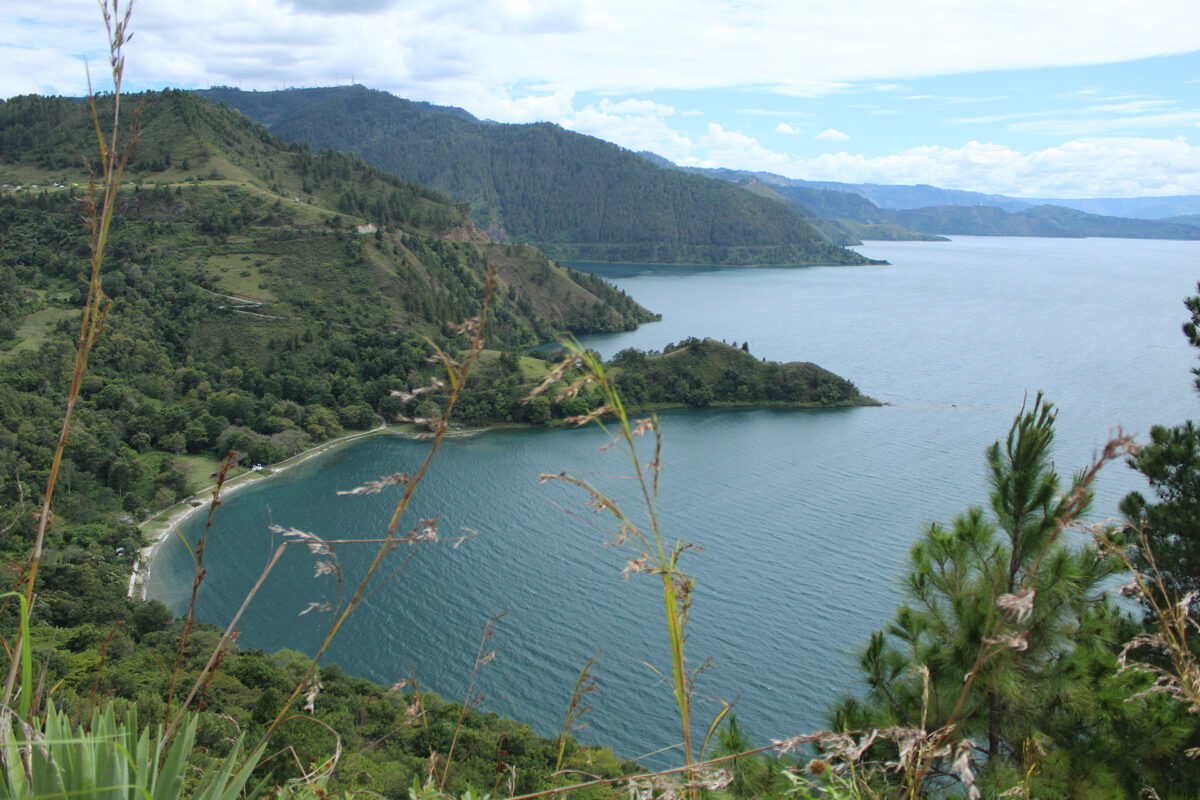The spring rain had just let up in Lintong Ni Huta, a village in North Sumatra, when 72-year-old Helmi Samosir sat on the floor of her terrace, sorting coffee beans. Her eyes work in sync with the movements of her fingers, hands quickly separating damaged coffee beans from the healthy crop.
Samosir has been cultivating coffee with her family for more than two decades, but in recent years she has been dissatisfied with the results. “The yields are bringing in less now,” she tells me, “and the quality is not as good as it used to be.”
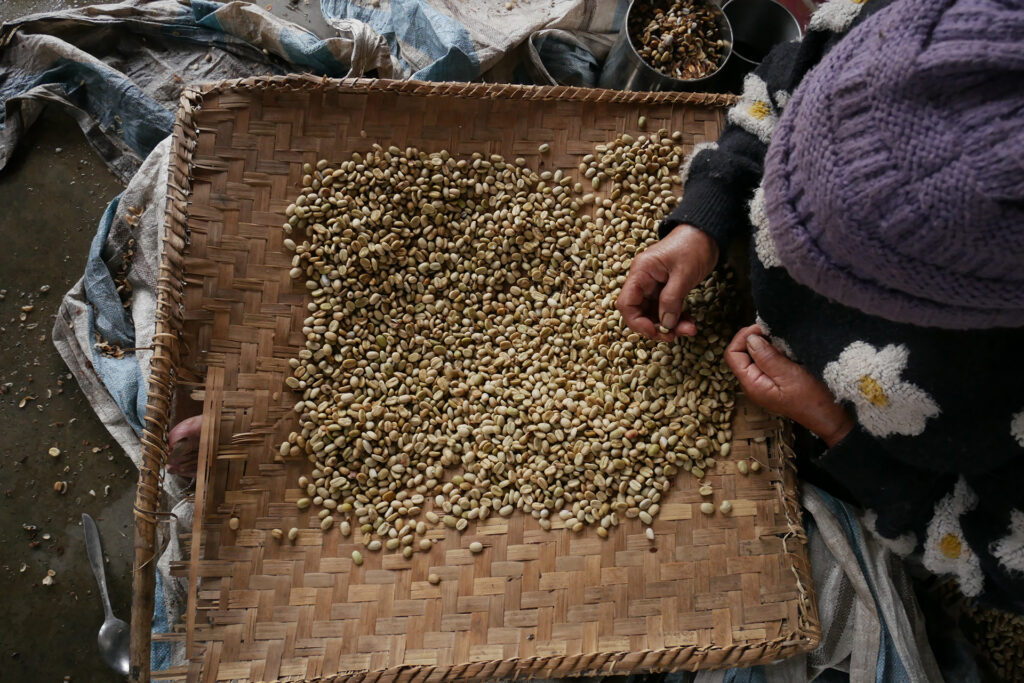
April to May is coffee harvest season in Lintong, and on the first picking day of the year, she’s able to yield around 15 kilograms of coffee cherries, which she places on a tarpaulin for sorting over the next two or three days. Coupled with the first picking, Samosir predicts that this year’s harvest will only be a maximum of 25 kg of cherry from 200 coffee trees in his family’s 1,600 square meter farm. Those numbers are dissatisfying.
“After this [first picking], for the next one to two weeks, there will still be one more picking, but maybe not this many anymore. After that, there is no more [picking]. Usually, the two pickings are gone,” she says, and I can see the disappointment on her face. Over the previous two decades, the average yield was closer to 80-90 kilograms per harvest, but the decline has been steady over the last few years.
Pests, disease, and climate all contribute to these dropping yields, and on the day I visited her, around 20 percent of what Samosir picked appeared to be defective. After sorting—one of the traditional post-harvest processes, from picking the cherries and pulping—she will dry them in her yard using tarpaulin mats on the ground and direct sunlight.
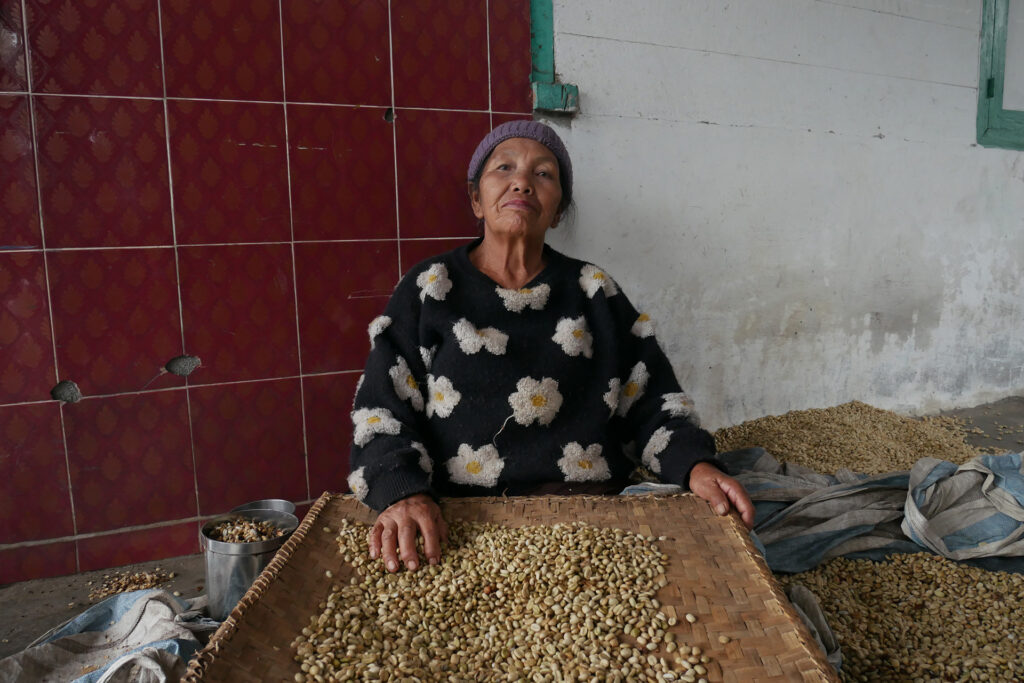
“Hopefully, it doesn’t rain so that the coffee can be dried immediately and can be sold immediately,” she says. Samosir hopes to sort everything in time to collectors, who will then sell it back to the factories that process them into green coffee that is ready for export.
But it’s not all bad news. “Now we sell unhulled coffee to collectors for US$2.8 per kilo,” she said. That price is almost three times what it was two years earlier, when the COVID-19 pandemic occurred and Arabica coffee exports were impacted. What’s happened since is an unusual dichotomy: coffee in this part of Indonesia has never been worth more, but the harvest has never been smaller. Helmi Samosir puts it simply:
“Prices are good, but the harvest is less.”
Lintong Ni Huta is one of the ten coffee-producing regions in North Sumatra, a province known as one of Indonesia’s largest coffee producers. Coffee from this region is called Lintong Coffee, which has been popular across the international coffee market since the 1990s, in particular via Starbucks, whose “Blue Batak” offering is sourced from this region. “Batak” refers to the tribal inhabitants of the area around Lake Toba, the largest lake in Sumatra, formed by a massive volcanic eruption—one of the largest known to geologic records—around 74,000 years ago. Lintong Ni Huta is one of several dozen villages that ring the shoreline of this lake.
Juandi Nababan, 43, is another coffee farmer I met in Lintong Ni Huta last spring, and he told a similar story about harvest and production, reporting that both the quantity and quality of coffee in his village had deteriorated considerably over the last decade. Borer pests appear to be the primary culprit.
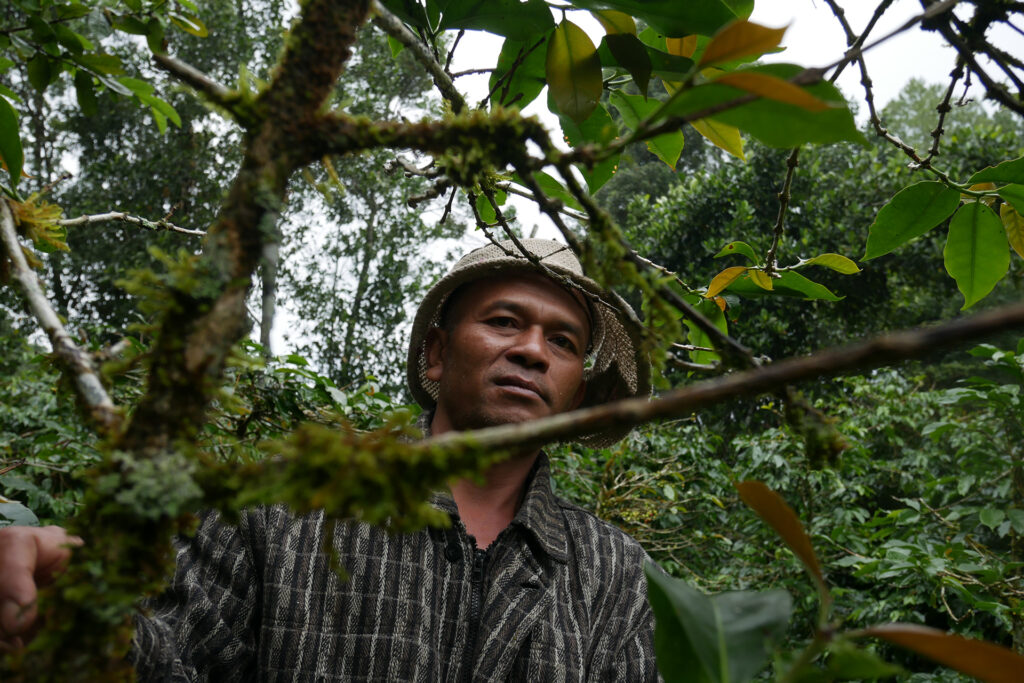
“This is the condition of the coffee tree now,” he says, showing me a coffee tree that looks stunted, with sparse leaves and stems covered in green, moss-like networks of pests. “This green is actually dying and not bearing any fruit.”
“This is a complete failure, serious, very bad.”
A few years after noticing the initial decline, Nababan and his family replanted most of the coffee trees on their small coffee farm. The problem continued, however, and the health of the plants worsened.
The first Arabica coffee seeds were brought by the Dutch to Indonesia in the 18th century. Beginning in 2005, the coffee farmers in and around Lintong have begun using a hybrid Arabica variety known as Sigarar Utang. The source of the seeds, which are the result of natural crosses of Typica and Catimor, were found in 1988 in a coffee field in Paranginan, a village on the shores of Lake Toba, owned by a farmer named Ompu Sopan Siregar. Almost two decades later, the Indonesian Ministry of Agriculture began issuing these seed varieties to farmers, and widespread adoption quickly followed.
“Almost all coffee farmers in this village grow Arabica coffee of the Sigarar Utang variety,” Nababan told me, and for good reason. The tree bears fruit quickly, allowing farmers to harvest fruit right at the three-year mark (most Arabica variety coffee trees can be harvested closer to 4 years after planting). This quick turnaround allows farmers to make money more quickly, and use the proceeds from sales to pay off debts, as most farmers borrow money in advance during planting season and pay it off after harvest. In a neat bit of local marketing, the name—”Sigarar Utang”—translates from Indonesian as “the debt payer.”
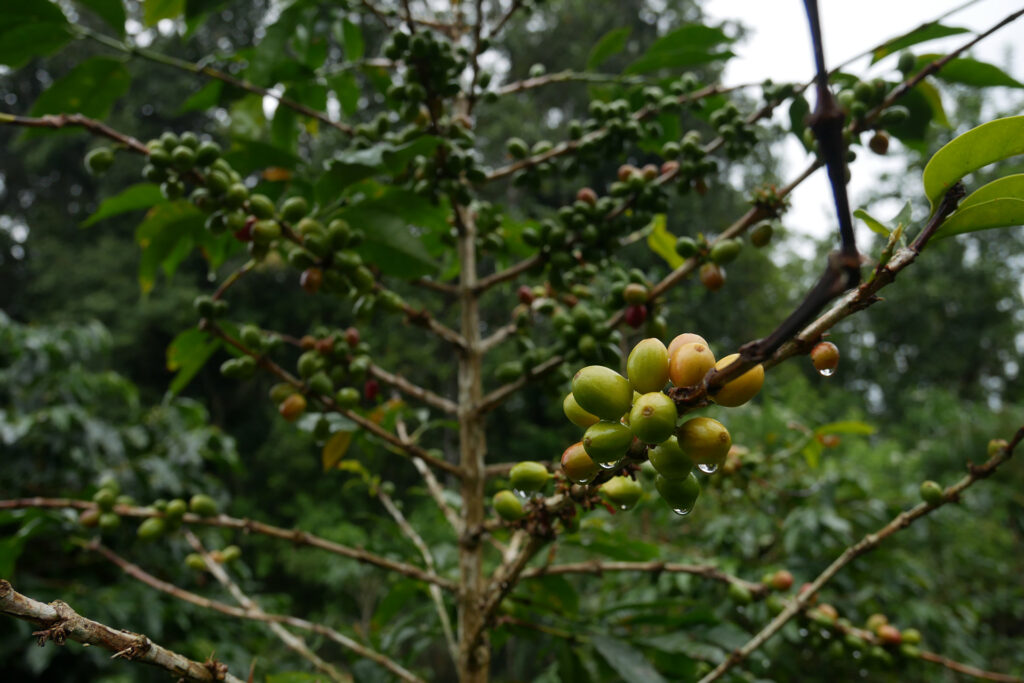
But nearly twenty years after being officially issued by the Indonesian government, it appears that Sigarar Utang can no longer keep up with disease, pests, and climate change. The variety appears to be particularly vulnerable to pests after passing its productive period, which can be anywhere from 5 to 20 years, and the high intensity of rain in the region during the month of October often aborts the coffee flowers so they don’t become coffee cherries.
“Five years ago, most of the coffee trees in this field have been replanted, but it’s been two years, seven years ago, pests and diseases have started,” said Nababan, showing red coffee cherries that looked intact but were damaged inside.
“When washed, there are so many cherries that float,” a tell-tale sign that your coffee’s fruit is impacted. “I would say up to one-half of each tree is in a damaged condition.”
Nearly every family in Lintong, around 280 or so groups total, farm coffee in the regions’ coffee fields. Beginning in the 1990s, around the same time Starbucks made Blue Batak a household name for coffee lovers, the villagers in this region turned coffee into their primary source of agricultural revenue. It’s now a multi-generational business affair, with coffee farming techniques (and profits) passed down from elders to children. “My mother used to harvest around 20 cans (roughly 340 KG) per pick from the 250 coffee trees in her field,” Nababan recalls, “at the time, coffee production was very high, and the prices soared.”
A number of coffee farmers in the area found themselves with real profits from the work, and were able to send their children to university, something that was not common in the region at that time.
But now, the villagers of Lintong are staring straight into a new reality as coffee conditions continue to decline. Many farmers are beginning the difficult work of shifting to other crops, including corn, chilies, and other vegetables. Coffee from this corner of Indonesia, once so prized, is slowly being phased out by families in the region.
For now, the Nababan family is holding steady. “I’m still enthusiastic,” says Juandi Nababan. He tells me that coffee has given a lot to his family: “From coffee, we can buy paddy rice, and it enables us to send our children to school.” But he acknowledges that a solution must be sought quickly to the growing production problems faced by the coffee farmers of Lintong. And he wants the government, which has been promoting Lintong coffee abroad for decades, to acknowledge the challenging conditions faced by farmers at the grassroots.
“It’s true that Lintong coffee is well-known overseas, but that was before. This is the real condition now,” he says.
“Coffee here is not what it used to be. It’s like a dream.”
Indonesia is the world’s fourth largest coffee producer after Brazil, Vietnam, and Colombia. Coffee is big business here, in a country with a coffee plantation area of 1.29 million hectares and a total production of 794.8 thousand tons as of 2022. But these numbers tell just one part of the story, and scale of production decreases significantly as you follow the statistics; Indonesia is nearly twice the size of Vietnam, but that nation now produces 1.85 million tons annually.
What’s happening around the village of Lintong Ni Huta in North Sumatra is a window into a more extensive set of issues facing farmers across the country. I spoke with Joko Prabowo, a Sumatran coffee exporter at PT Sumatra Specialty Coffee (SSC), which since 2007 has been supplying coffee to Starbucks from farmers in the 10 regions, who said coffee production from farmers has dropped dramatically in the last three years.
Once upon a time, SSC assisted some 21,000 coffee farmers—a number now reduced to 10,142—as registered members of the C.A.F.E Practice, Starbucks’ certification program, in determining standards and sustainability of coffee production. In the provisions of C.A.F.E Practice, it is explained that Starbucks pays a premium to farmers. However, according to Prabowo, there is no premium paid by Starbucks to farmers because farmers in North Sumatra are generally non-organic farmers.
“The premium is given to organic farmers,” he said. “Starbucks only provides development assistance and coffee seeds. This year, Starbucks plans to distribute 1.6 million seeds to farmers in North Sumatra alone,” said Prabowo, whom Sprudge met at the coffee collection warehouse in Siborong-borong.
When asked what caused the reduction in certified farmer members, he said the trigger was the COVID-19 pandemic. When coffee trading stopped, and coffee prices fell, many farmers switched to planting other crops, which had an impact on decreasing coffee production.
Before the pandemic, SSC exported 10-15 containers of green beans to Starbucks a week, and those numbers are slowly returning. Now that trade is starting to stabilize, and coffee prices are rising, farmers want to grow coffee again, but production remains small, impacted by the double circumstances of decreased yields and farmers who are just now bringing their crops back online.
“Many farmers who stopped growing coffee now regret that decision,” Prabowo tells me, “especially with prices like this.”
Based on data from the Central Statistics Agency, the area of Arabica coffee plantations in North Sumatra is 79,388.64 hectares, with production of 71,588 tons in 2021. Humbang Hasundutan is a region that has the largest coffee plantation area of 12,163 hectares. Its production is 9,690 tons and has slowly decreased over the last few years.
According to Harapan Munthe, secretary of the Lintong Coffee Observer Society (an association of Lintong coffee farmers and entrepreneurs), now the average production is even lower, only 500 kg to 600 kg per hectare per year, lower than statistics which average 700 kg per hectare per year.
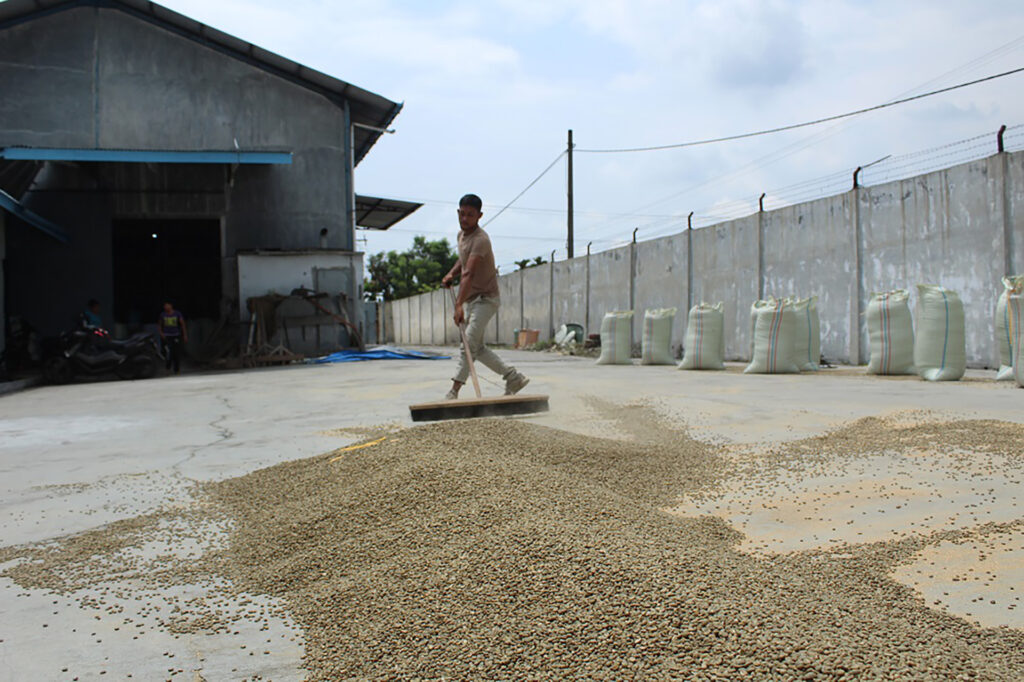
However, the market demand for this coffee remains high, so it is impossible for traders to sell large volumes of Lintong coffee. If anything, there is a possibility of fraudulent trading. “Traders buy coffee from farmers in other regions and then sell it under the name Lintong coffee,” Munthe told Sprudge. Other coffee producers I spoke to for this article agree that fraud is a new issue here in the region.
To avoid fraud, according to Munthe, the government has issued a geographical indication that was proposed by the district government to identify the original origin of coffee from the region. But the initial impact of the certification has been limited, says Munthe. “The trade link is still through exporters,” he explains, and many exporters selling coffee from North Sumatra still use the label Sumatra Mandheling Coffee, which refers to the Mandailing district where the Dutch first planted coffee in northern Sumatra in the 18th century. This term—”Mandheling”—has name-brand popularity abroad, and it remains on exporter sheets today alongside Sumatra Arabica Coffee, a term that generalizes coffees sourced from all ten regions on the island, even if they happen to be from the protected distinct region of Lintong.
Until only recently, farmers in the region have not been able to determine the market value of their coffees fairly, according to Munthe. Prices set by exporters in the market have impacted farmers’ motivation to cultivate their coffee, with a knock-on effect of impacting the total supply availability, which is also being harmed by pests and climate change. “Geographical indication certification should enable farmers to export their coffee to the market directly,” Munthe tells me. And in this work, he sees a glimmer of hope.
15 kilometers or so outside the village of Lintong Ni Huta, in Siborong-borong, a coffee producer named Surip Mawardi manages 3.8 hectares of land. His parcel was previously uncropped—”it used to have bushes and some pine trees, he says—until Mawardi planted it to coffee for the very first time in 2020.
Mawardi is a retired researcher from the Indonesian Coffee and Cocoa Research Center. Before he began managing coffee fields, he worked for the Starbucks Farmer Support Center in Karo District, North Sumatra. His land sits around 1400 meters above sea level, and he grows four different types of coffee, including Komasti, Andung Sari 1, Tipika, and Long Berry.
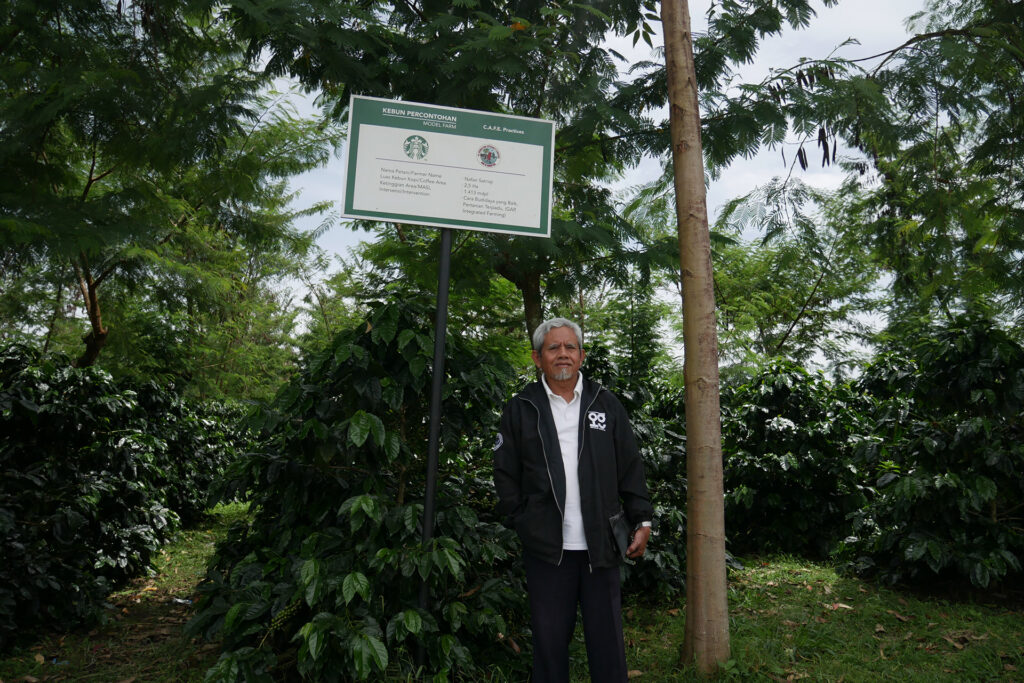
In early April of this year, Mawardi started harvesting coffees from the Andung Sari 1 variety shrub. These treelets yield well, offering as much as .5 kilograms of green coffee per tree, and he assumes that if this average holds out across the 3,000 trees he’s planted, the yield from one hectare can reach 1.5 tons.
These numbers add up in a significant way for the farmer. “It will be like an ATM for me, making money all the time,” Mawardi says. “After fruiting, the cherries can be picked every two weeks, and the peak will be in October to November.” This only happens in Sumatra, he adds—on Java the crops peak closer to the end of September.
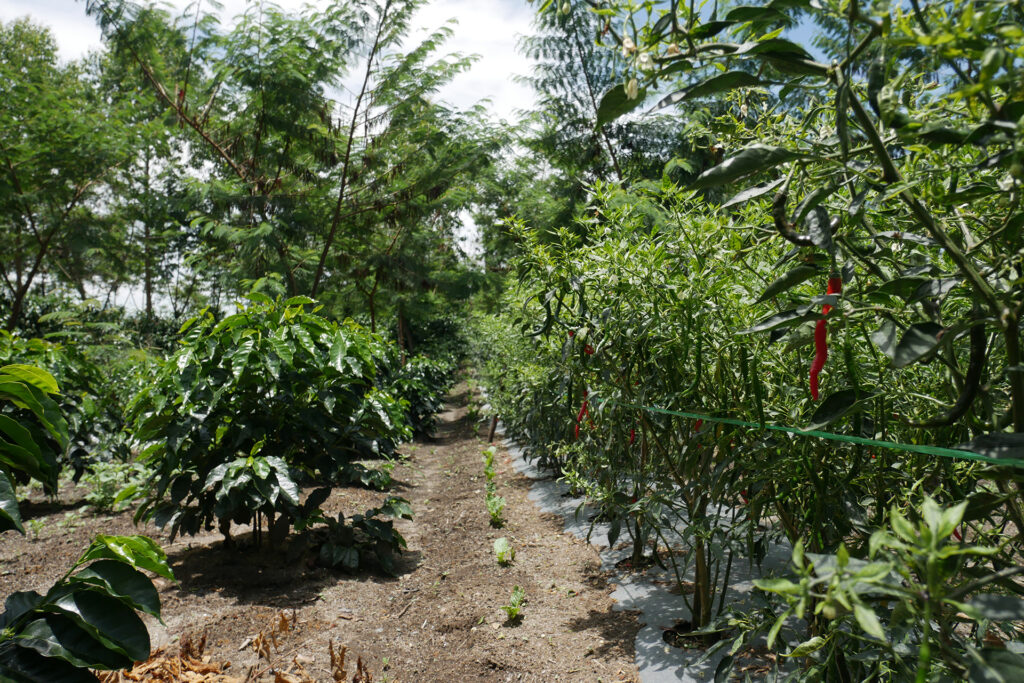
As a member of the C.A.F.E Practice farmer network, Mawardi sells wet parchment to Starbucks through exporters and processes a small part of it for local coffee shop demand. For good quality coffee, he can sell wet parchment for US$6/kg, and for US$8/kg after being processed into specialty green beans.
He admits that the lack of cultivation guidance for farmers is a problem for the sustainability of coffee farmers. Most coffee trees after seven years are no longer productive, and farmers do not replace them with superior seeds, which makes them vulnerable to pests. “Sigarar Utang has passed its golden age. It was ahead of its time,” he says.
Surip Mawardi advises farmers to change cropping patterns by using superior seeds (such as Andung Sari 1) that are resistant to pests and climate change. Land preparation practices using compost and shade systems using local shade trees like lamtoro also have a profound impact on oxygenation in the soil, helping protect the health of the coffee plants.
The key is spreading knowledge about these practices and convincing farmers that they can continue Lintong’s legacy of artisan coffee cultivation, especially now that prices are at an all-time high. Coffee quality can even improve, he says, and quantities grow exponentially across harvests, starting first in smaller areas and then growing in the next planting period.
“If that can happen, I’m sure there won’t be a shortage of Sumatran coffee in the midst of high demand like now,” he tells me, as we stand together on his small coffee farm in the April heat. “And there won’t be any more poor coffee farmers, either.”
Tonggo Simangunsong is a freelance journalist based in Medan City, North Sumatra, Indonesia, the author of Medan Coffee Guide. Read more Tonggo Simangunsong for Sprudge.
